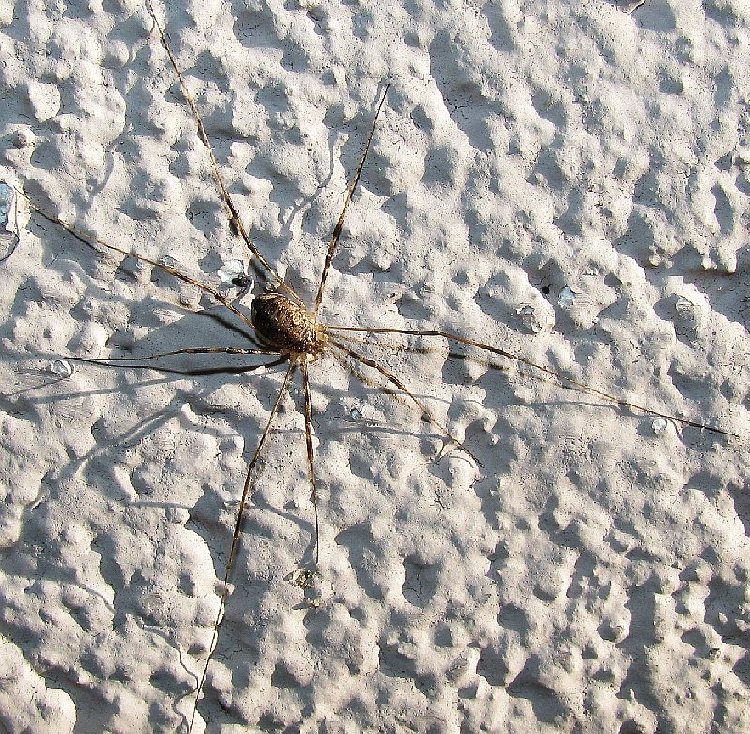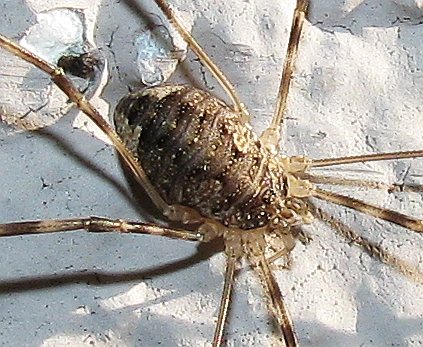|
|
|
|
|
Galleria Tassonomica
di
Natura Mediterraneo
|
 ATTENZIONE! Con tutti gli opilionidi è estremamente importante vedere l'oculario e la zona di fronte ad esso. Questo è vero in particolare per gli opilionidi a zampe corte nei quali il tridente è una caratteristica distintiva. ATTENZIONE! Con tutti gli opilionidi è estremamente importante vedere l'oculario e la zona di fronte ad esso. Questo è vero in particolare per gli opilionidi a zampe corte nei quali il tridente è una caratteristica distintiva.
Si dovrebbe misurare la lunghezza del corpo. Se è possibile scattare fotografie prese dall'alto e di lato. Naturalmente non dovrebbe mancare una semplice foto dorsale. Anche se sono la caratteristica più notevole degli opilionidi, le zampe possono essere ignorate senza problemi perché non hanno virtualmente alcun ruolo nella determinazione.
Per la maggior parte degli Opiliones si arriva ad una determinazione già con le foto. Le eccezioni sono Nemastomatidae ('i piccoli neri') e soprattutto Trogulidae, per i quali è meglio l'analisi del DNA.
|
|
| Autore |
 Discussione Discussione  |
|
|
Levent
Moderatore
   
Città: Istanbul
Regione: Turkey

1954 Messaggi
Flora e Fauna |
|
|
Lars Friman
Utente Senior
   
Città: D-14806 Bad Belzig

680 Messaggi
Flora e Fauna |
 Inserito il - 13 aprile 2013 : 20:11:58 Inserito il - 13 aprile 2013 : 20:11:58


|
Moin Levent,
it is a Phalangiidae, but after my opinion it is not Phalangium
(legs too short, too massiv and too edgy). It looks a bit like
Oligolophinae, unfortunately one can not see if it has a trident.
Perhaps it is a Metaphalangium? I will take a look which species
has been found in Turkey.
Lars Friman |
|
Modificato da - Lars Friman in data 13 aprile 2013 20:14:03 |
 |
|
|
Levent
Moderatore
   
Città: Istanbul
Regione: Turkey

1954 Messaggi
Flora e Fauna |
 Inserito il - 13 aprile 2013 : 20:50:26 Inserito il - 13 aprile 2013 : 20:50:26


|
Hi Lars Friman,
67 Opilionid species have been recorded from Turkey till 2010
Considering Metaphalangium genus, there are 2 species recorded already.
Metaphalangium cirtaum (C.L. Koch, 1839)
Metaphalangium strandi (Nosek, 1905) This is endemic to Turkey
From subfamily Oligolophinae;
Lacinius ephippiatus (C.L. Koch, 1885)
Mitopus morio (Fabricius, 1779)
Oligolophus hansenii (Kraepelin, 1896)
Oligolophus tridens (C.L. Koch, 1836)
Hope the data above will help to designate the exact species.
|
|
Modificato da - Cmb in data 10 giugno 2013 20:55:23 |
 |
|
|
Lars Friman
Utente Senior
   
Città: D-14806 Bad Belzig

680 Messaggi
Flora e Fauna |
 Inserito il - 14 aprile 2013 : 20:16:43 Inserito il - 14 aprile 2013 : 20:16:43


|
Moin Levent,
yes, I have the paper of Bayram et al. (2010, checklist), where
the Oligolophus-specimens are mentioned. But first of all (sorry
to say) we need a better picture of the specimen. Especially the
front rim of the prosoma would be very interessting ("to trident
or not to trident").
Lars Friman
P.S. a wild wild quess: e.g. O. hanseni has a somewhat similar
saddle-figure on its opithosoma, like that in your picture. |
|
Modificato da - Lars Friman in data 14 aprile 2013 20:18:08 |
 |
|
|
Levent
Moderatore
   
Città: Istanbul
Regione: Turkey

1954 Messaggi
Flora e Fauna |
 Inserito il - 16 aprile 2013 : 21:21:43 Inserito il - 16 aprile 2013 : 21:21:43


|
Hi Lars Friman,
Unfortunately I have only one photo of this specimen.By the way I had taken photo of another Opiliones on my garden wall in fall 2011.What species could it be ?Thanks in advance.
Immagine:

276,19 KB
Immagine:

67,81 KB |
|
 |
|
|
Lars Friman
Utente Senior
   
Città: D-14806 Bad Belzig

680 Messaggi
Flora e Fauna |
 Inserito il - 03 giugno 2013 : 09:26:17 Inserito il - 03 giugno 2013 : 09:26:17


|
Moin Levent,
I've checked all my specimens from mediterran aree. I have a
similar Phalangiidae-specimen from Greece (leg. Arno Grabolle)
but that one is also not yet identified. So it takes time.
Greetings
Lars Friman
|
|
 |
|
|
Axel
Utente

Città: Mainz

20 Messaggi
Flora e Fauna |
 Inserito il - 10 giugno 2013 : 19:08:14 Inserito il - 10 giugno 2013 : 19:08:14


|
Hi Levent,
The turkish cheklist should be used carefully as it is very incomplete and contains many errors. Also it is not a good idea to identify species with the Central European key by Martens (1978), who does only marginally cover the fauna. So all the Oligolophinae you mentioned are not living in your area.
For your species the first is probably from the genus Zacheus. It has a faint light stripe on the back and whitish patches at its rear. As the leg I is not thick and swollen, your specimen is probably a female. I am not able to tell the species, that would be best to have a male.
Your second species is an Opilio. Species identification is also difficult if you have no males, also you need to dissect, and yours looks like a female. It reminds me of Opilio ruzickai, that is widespread on the Balkan Peninsula, so that could be a likely possibility.
Cheers!
Axel |
|
 |
|
|
Lars Friman
Utente Senior
   
Città: D-14806 Bad Belzig

680 Messaggi
Flora e Fauna |
 Inserito il - 13 giugno 2013 : 15:37:31 Inserito il - 13 giugno 2013 : 15:37:31


|
Moin Axel
and thanks for Your comments to the rather new (?) paper of
Bayram et al. (2010, checklist). Could You tell us, where we
could find a more correct list of opiliones from Turkey? Or can
You tell us/me, how can You exclude the mentioned Oligolo-
phinae from the Bayram-Checklist?
Greetings
Lars Friman |
|
 |
|
| |
 Discussione Discussione  |
|
|
|
 Natura Mediterraneo Natura Mediterraneo |
© 2003-2024 Natura Mediterraneo |
 |
|
Leps.it | Herp.it | Lynkos.net
|

 Forum
|
Registrati
|
Msg attivi
|
Msg Recenti
|
Msg Pvt
|
Utenti
|
Galleria |
Map |
Forum
|
Registrati
|
Msg attivi
|
Msg Recenti
|
Msg Pvt
|
Utenti
|
Galleria |
Map |